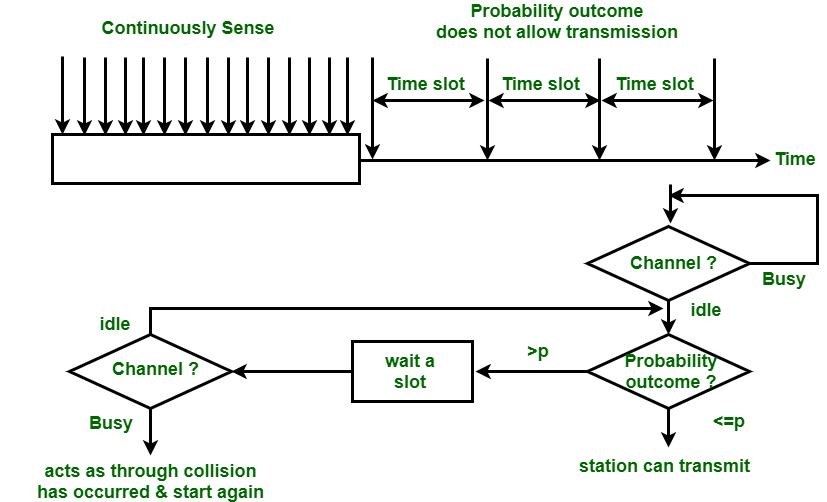先决条件–载波侦听多路访问(CSMA)
1.非持久性CSMA:
在非持久CSMA中,具有帧的站仅发送该信道的信号。在空闲信道的情况下,它将立即将帧发送到该信道。如果发现信道繁忙,它将等待一段固定的时间,然后再次检测到该站的状态为空闲还是繁忙。在这种方法中,当站检测到先前传输的结束时,它不会立即仅出于捕获信道的目的而立即感知到该信道。这种方法减少了冲突的机会,但降低了网络的效率。

2. p持久CSMA –
当一个信道具有时隙并且该时隙的持续时间等于或大于该信道的最大传播延迟时间时,使用p-persistent CSMA。当电台准备好发送帧时,它将感应到该频道。如果发现信道繁忙,则电台将等待下一个时隙。但是,如果发现该信道空闲,则该站立即以概率p发送该帧。因此,该站等待下一个时隙的开始的左概率即q等于1-p。如果下一个时隙也被发现空闲,则该站以概率p和q发送或再次等待。重复此过程,直到发送帧或另一个站开始发送。

非持久CSMA与p持久CSMA之间的区别:
| Parameter | Non-persistent CSMA | p-persistent CSMA |
|---|---|---|
| Carrier sense | When channel is idle, it will send frame. | When channel is idle, it will send with probability p. |
| Waiting | It will wait for a random amount of time to check the carrier. | It will wait for the next time-slot for the transmission of frames. |
| Chance of collision | In this method, chance of collisions are more than in p-persistent. | In this method, there are less chances of collision than in non-persistent. |
| Utilization | Its utilization is above 1-persistent because in this all the stations constantly check for the channel at the same time. | Its utilization depends upon the probability p. |
| Delay low load | It is longer than 1-persistent as it only checks randomly when the channel is busy. | It is large when the probability p is small because the station will not send always in the idle state of the channel. |
| Delay high load | It is high due to collision. | It is large when the probability p of sending is small when the channel is found in the idle state. |